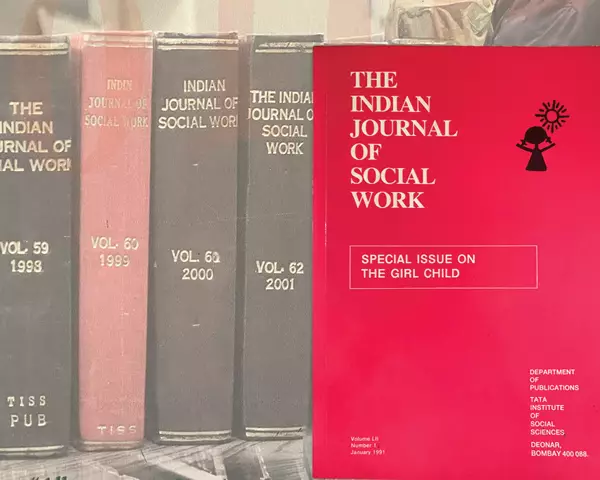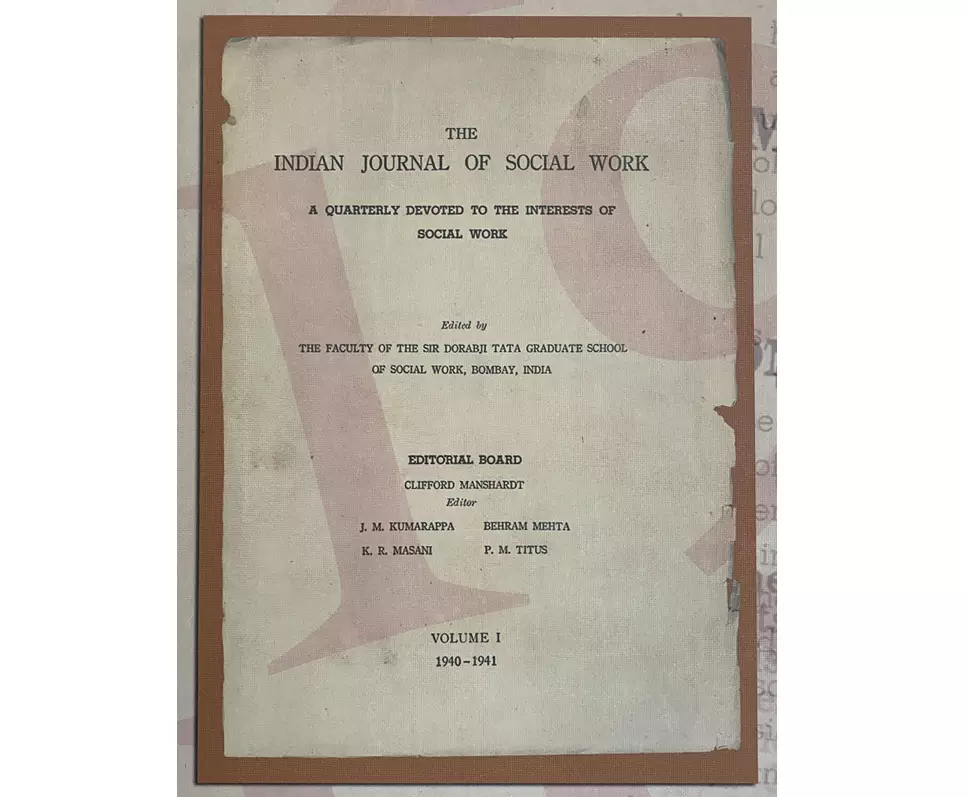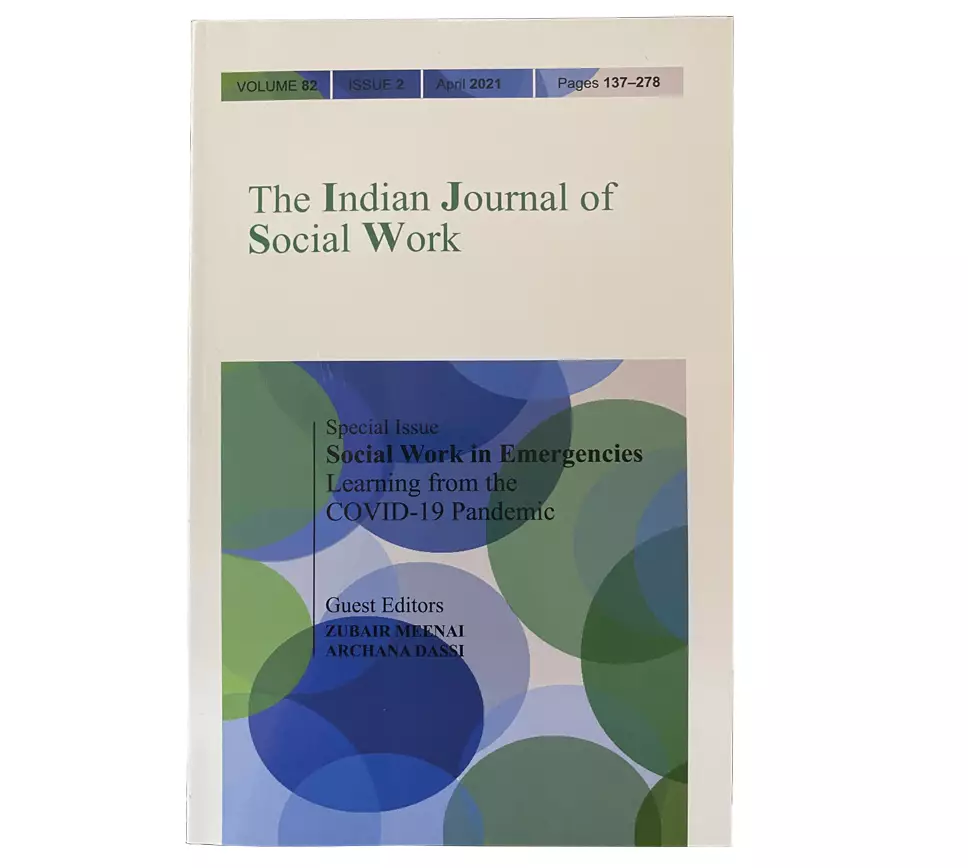A print journal: The life and soul of TISS for 82 years
One of the oldest Indian journals, the history of the IJSW is the story of the social work profession in India from its early days to present times. Dibyajyoti Sarma learns the inside story from Sudha Ganapathi of TISS
14 Apr 2022 | By Dibyajyoti Sarma
The Indian Journal of Social Work (IJSW), published by the Tata Institute of Social Sciences (TISS), is the oldest journal of social work in India, and one of the oldest Indian journals. First published in June 1940, the IJSW has been printed uninterruptedly since then, that too in print. PrintWeek was informed about the publication, and the extraordinary work done at the publications unit of TISS recently by Amol Paranjape, development and communications officer at TISS. Our interest piqued sufficiently, we had a long conversation with Sudha Ganapathi, manager (publications), TISS.
According to Ganapathi, IJSW was the result of a felt need at the Tata Institute of Social Sciences (earlier known as the Sir Dorabji Tata Graduate School of Social Work) to have a journal “devoted to Indian social problems”, and to “document the work being carried out by social workers and organisations”.
The IJSW came into existence in June 1940 as a quarterly “devoted to the interests of social work”. The focus of the first issue was on two aspects of child welfare – children in industry, and juvenile delinquency. It had a mix of articles, book reviews, notes and comments, a report on the second convocation of TISS and alumni news. Dr Clifford Manshardt, the first director of TISS, was also the first editor of the IJSW and led a four-member editorial board, which had stalwarts like JM Kumarappa,
Behram Mehta, KR Masani and PM Titus as members.
The tentative subscription price, as mentioned in the first issue of the IJSW, was Rs 10 for India, Burma and Ceylon; for all other countries it was Rs 11. The first volume had no ads, but from the second volume onwards the IJSW started carrying ads, which included publishers like Russel Sage Foundation; periodicals like The Visva-Bharati Quarterly, The Indian Co-operative Review, and the Social Welfare, and others like The Bombay Provincial Co-operative Bank, Shangrila Food Products, Johnson &
Johnson, Mahindra & Mahindra, and many more. Ads in the IJSW were discontinued in 1996.
Ganapathi says the history of the IJSW is the story of the social work profession in India from its early days to present times. From early challenges to dilemmas to growth to adapting to the external environment to highlighting social issues, initiating debates and discussions — the IJSW has documented it all and continues to do so. One of the ways it does this is by bringing out special issues, which are timely and topical.
Ganapathi gives two examples.
In 2008, the ministry of women and child development declared 24 January as the National Girl Child Day. Much before this, the IJSW had published a special issue on the girl child in January 1991 .
In April 2021, the IJSW brought out a special issue on “Social work in emergencies: Learning from the Covid-19 pandemic” (Vol 82, Issue 2) with the aim to help social workers during emergencies.
Dibyajyoti Sarma (DS): Is it a monthly, bi-monthly or annual publication?
Sudha Ganapathi (SG): The IJSW has always been a quarterly publication. Until 1962, it was published every June, September, December and March. Thereafter, it changed to every April, July, October and January. From 1990 onwards, every volume had four issues published in the months of January, April, July and October of the calendar year.
The IJSW is distributed via paid subscriptions. In addition to this, we have exchange agreements wherein we send the journal to certain organisations in exchange for their journal. The exchange journals are sent to our TISS Library.
DS: What kind of paper do you use? What is the average number of pages of the journal? How many copies do you print?
SG: The IJSW has been printed on different kinds of paper over the years, but in the last 10 years or so it has been printed on 80-gsm Maplitho. The average number of pages per issue is 136, but in the case of special issues, the number of pages can double. The print run for the IJSW is 2,000 copies, but in the case of special issues, the print run can increase depending on the perceived demand.
DS: Tell us about the publication process.
SG: The IJSW is the flagship publication of the Tata Institute of Social Sciences and has always been published by it. While it is not associated with a particular department, the Publications Unit of TISS is responsible for IJSW print production, subscriptions and distribution. The IJSW is handled by a four-member team.
From its inception, the director of TISS has been the editor and publisher of the IJSW, and the current director, Prof Shalini Bharat is the editor and publisher now. The director is also the chairperson of the IJSW editorial board, which is made up of members drawn from TISS faculty and external experts in the field of social work and social sciences. In addition to this, the IJSW also has an international advisory board.
The associate editor is the face of the IJSW and is responsible for, among other things, advising the editorial board on the journal’s goals and scope, editorial style, and the review system; and corresponding with the authors, referees and guest editors. Prof Surinder Jaswal (deputy director, TISS) has been the associate editor of the IJSW since April 2002.
The publication process is similar to that of any quality journal — reviewing, editing, typesetting, checking, and finalising both the print and digital versions. Once we acquire the digital object identifier (DOI) for every article in an issue, the digital version is uploaded, and the print version is sent to the press. While the issue is in press, the subscription list is given a final check and updated, address labels printed, and envelopes readied. Within two days of receiving the printed copies, all issues are dispatched to our subscribers.

Sudha Ganapathi: As long as there are readers, there will be a demand for print
DS: Tell us about the printing of the journal?
SG: The IJSW has never had an in-house printer and has always relied on an external printing partner. The first few volumes of the IJSW were printed by Tatva-Vivechka Press in Mumbai, and subsequently we have had many other partners such as Tata Press, India Printing Works, Plascote Industries, and Specific Assignments. Our longest association has, however, been with India Printing Works of Wadala, Mumbai, with nearly half the IJSW volumes having been printed by them.
DS: The printing technology has changed considerably since the 1940s, first letterpress, then offset, and now digital for short-run printing. How do these changes reflect in the long journey of the journal?
SG: The IJSW is currently printed by the offset method and has been for quite some time now. We have not yet switched over to the digital method but I think this may change in the future — maybe in this decade itself — if and when we adapt or change to print-on-demand or short-run printing.
Looking at 82 volumes or 328 issues of the IJSW is akin to looking at changes in printing technology. The early volumes have been printed using the letterpress method and even though the paper has yellowed and is sometimes stiff and brittle, the print is still sharp and it is a real pleasure to run one’s hands over the pages and feel the raised letters. The more recent ones have been printed by the offset process and the look as well as feel is very different.
In the late 1990s and early 2000s, we would print the final “camera-ready copies” on tracing paper with the matter printed in reverse, which would then be hand-delivered to the printing press. Today, the printready file is a pdf file sent via email. A click on the send button is all it takes to send the file to the printer. While the printing technology, content and content delivery has changed in the eight decades since the IJSW began, what has not changed is how they have continued to adapt to remain relevant to the times they are located in.
DS: You mentioned that though a digital version of the IJSW is available, the print version has not been discontinued as TISS. What do you think about the relevance of printing in the increasingly digitised world?
SG: The print version has not been discontinued because, simply put, there is still a demand for it, especially from our subscribers based in rural areas of India. While a digital version is convenient, the power of print still prevails. I think ink on paper is important because it conveys a sense of reality — literally something in black and white. This is the reason why printing in an increasingly digitised world will always be relevant and exist in some form or the other.

The first issue of the Indian Journal of Social Work (IJSW)
DS: Post-pandemic, it appears that education is relying more and more on digital than print. Do you think print is in the danger of losing out in the future?
SG: I have been hearing about the demise of print for the last three decades now. It hasn’t happened yet and I am confident that it will never happen. While print runs have shrunk, technology and even content has changed, and other unknown factors continue to rise, I am confident that as long as there are readers there will always be a demand for a print version.
DS: In the same vein, what do you think about the future of humanities in education?
SG: In a country obsessed with STEM, humanities and social sciences have always managed to hold its own. The National Education Policy 2020 also places a lot of emphasis on social science education. With science and technology institutes, B-schools and management institutes also looking to enter the field of social science education, it only means that the future is good. This also means that the future of publications like the IJSW is also good.
DS: Please mention some of your favourite issues? Or essays published in the journal?
SG: There are too many to mention. But there are three IJSW special issues very close to my heart — Social Research Methods: Persistent Issues and Emergent Trends (Vol 67, Issues 1&2, 2006); The Social Construction and Expression of Ethnicity and Identity (Vol 57, Issue 1, 1996), and Towards People-Centred Development (Vol 59, Issue 1, 1998). An article that has immediate recall is one by Aniruddh Prasad on The Musahars of Bihar: A Dalit Community in the Vortex of Change” (Vol 68, Issue 1, pp.152-167, 2007).
DS: What are three things about the book-making process you learnt during the pandemic?
SG: I read some remarkable books during the pandemic, including a few that had something or the other to do with book-making or printing. Ironically, I read most of the books on an eBook reader. Three books that I really enjoyed reading were Meetings with Remarkable Manuscripts by Christopher De Hamel; The Great Mysore Bhagavata: Complete Study of a Manuscript from the Binney Collection, San Diego Museum by BN Goswamy, and A Printer’s Paradise, the Plantin-Moretus Museum at Antwerp by TL Low De Vinne, BKP Cu-Banc, and EE Grabhorn.
I love history, particularly micro-history and these books were a treat to read. I got to know of different manuscript traditions, their production and preservation, the stories they contained and so much more. The last book on the Plantin-Moretus Museum was special because I had visited it about six months prior to lockdown.

The recent Covid-19 issue of IJSW
DS: Your plan for 2022?
SG: Two general issues and two special issues are being readied for release in 2022. The working titles for the two special issues are Tribes and Development in India, and Queer Affirmative Mental Health Practice in India.
DS: The future of the TISS journal? Where do you see it in 2030?
SG: I see the IJSW in its 90th year with a new team in place bursting with dynamism and ideas. It is going strong and continuing to be relevant, not just to social work, but the broader field of social sciences. The print and digital subscriptions are equal in number, and who knows we may have an audio and a braille version too.
SUDHA GANAPATHI: AT A GLANCE
Conversations with Anand Limaye of IPW?
Apart from the usual talk of printing and delivery schedules, as well as billing and payment, we have spoken about the lockdown and how it had impacted us, albeit in different ways.
One area of improvement?
More than the print part of the production, we are currently looking at design and layout improvements for the IJSW though we may not be able to implement all of them in 2022.
Which binding process (paperback / hardcover)?
Personally, I don’t have a preference. What is important for me is the quality of binding, which is one of the reasons I prefer section-sewn to perfect binding.
Which paper and inks and plates does IPW deploy?
For the IJSW, the paper used is maplitho, the ink is Toya and the plates are Technova CTP.
Three authors you like to contribute to the journal?
The late Verrier Elwin (anthropologist and ethnologist), Prof Armaity S Desai (former director, TISS, and former chairperson, UGC), and Prof N Jayaram (former faculty member, TISS, and visiting Professor, NLSU, Bengaluru). All three have contributed to the IJSW and I have learnt a lot from reading their works.
The future of reading books?
Books will always exist in some form or the other — print, digital, audio — and there will always be readers. So, I don’t fear that. What I do fear is that perhaps a time will come, far into the future, when the printed book will only be seen in museums as an object of the past to be revered, wondered upon or maybe ignored as a boring exhibit.
A TISS journal essay that everyone should read?
I would recommend Prof N Jayaram’s piece titled Blending Sociology and Social Work: An Overview of MS Gore’s Writings, which was published in the October 2021 issue of the IJSW (Vol 82, Issue 4, pp. 429-448).














 See All
See All